Facilities (Learning Spaces)
Outdoor Learning Environments
- By Jake Kelly-Salo, Jason Mellard
- February 1st, 2018
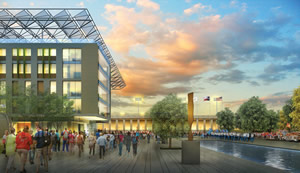
PHOTO COURTESY OF CORGAN
Learning and growth happens when students make positive connections to the world around them, to ideas, to others and to their future. The intentional design of the environment outside the walls of a school, anchored in a sense of place and discoverable by all the senses, provides unique opportunities for learners of any age to expand their reach.
At the outset of a project, a thorough environmental analysis and visioning with the community, students, and staff provide a needed base for decision making and curriculum integration. In addition, allowing the “memory” of a place—its history and significance—to influence the design can honor the community and communicate the value of place to students. During planning, it can be helpful to include specific outdoor functions into the program to maximize their potential and keep them from being leftover spaces. The design of outdoor environments should not stop at the playground.
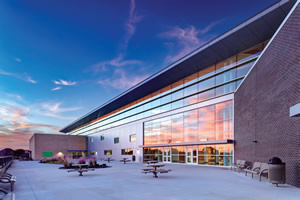
PHOTO © KURT GRIESBACH
Anchored in Place
In the development of a proposed S.T.E.A.M. academy in the heart of the Fort Worth, Texas arts district, Corgan referenced the iconic Kimball Art Museum, the Modern and the historic stockyards in developing not only the rhythmic massing of the building, but in prioritizing the incorporation of a public esplanade available for parades, celebrations, STEM demonstrations, and art exhibits. The public spaces offered by the school and its precedents are as much an integral part of the city fabric as the buildings they contain. This concept of a “common ground” was paralleled by a “common sky” which manifested in an expansive roof terrace at the same elevation as the downtown towers across the river. The goal was to create a school that was not just in the city, but of the city. These site decisions underscored to the students that what they were learning in school had direct relation to the larger arts community and the professional world which they would help shape.
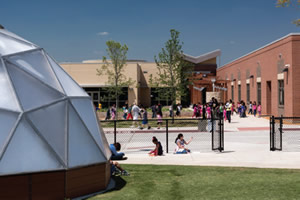
PHOTO © CHARLES DAVIS SMITH, AIA
A regional approach was used to craft the building and site design of Argyle Middle School, for Argyle ISD in Texas. The Texas Hill Country vernacular envisioned by the district incorporated regional materials such as Lueders limestone, decomposed granite and native plantings. Deep overhangs were used to shade both the glazing as well as outdoor seating and collaboration areas. Large scale classroom, athletic and fine arts blocks are connected by low scale corridors to create the feel of a small village, while varied ground materials further break up the outdoor space. The influences of this regional style fostered outdoor collaboration and leisure spaces that are functional and pleasant, and allows the site to be a teaching tool integrating both history and sustainability.
A Clear Train of Thought
Learning environments on the site will have the greatest impact and use when they facilitate activities that extend and compliment concepts introduced in the classroom. Just as the history of a place can be taught using the projects described in the previous paragraphs, many hands-on opportunities can be developed for subjects such as science, math, and art. Sundials and shadow walls can be placed to allow the rays of the sun to demarcate the hours and seasons. Butterfly gardens promote student inquiry regarding various species, metamorphosis and migration. Composting and water collection can be used in concert with vegetable gardens to illustrate the cycle of growth and decay.
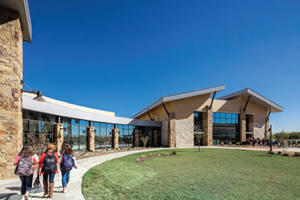
PHOTO © CHARLES DAVIS SMITH, AIA
Shaded outdoor project labs are touch down areas where data can be recorded and analyzed. These spaces require accessibility to water, power, storage for tools and tables to rest clipboards and tablets. In addition, visual and physical transparency from inside the school to these focus areas cue students to the unique learning opportunities outdoors. For STEM, construction, welding, and robotics maker spaces, covered canopies, multi-phase power, wash down areas, heaters, and secure fencing should be considered.
Taking It All In
By highlighting various ecological processes, schools can foster an appreciation within students for the natural world and the importance of its preservation. Solar panels, water wheels, and wind turbines provide real-time connections to energy harnessing of sustainable resources. At the Lorenzo De Zavala Environmental Science Academy in Grand Prairie, Texas, rainwater cascades off a butterfly roof, down a series of flumes and into a water collection cistern where it can be used to water planting beds and to illustrate river formation in the stream table. A meandering trail connects these elements with a geodesic domed greenhouse and chicken coop.
Rich experiences in planned environments provide students with greater retention and retrieval of what they learn. This is especially true of primary students who are at a crucial point in the development of their senses. The coarse texture of bark, the rustling of leaves, and the trickle of water engages their senses where smooth walls and artificial lighting fall short. Water walls, textured surface treatments, stepping stones, and outdoor musical and tactile elements foster development of motor skills through interaction and experimentation. Active learning occurs when students test a theory or observe a dynamic mechanism in action.
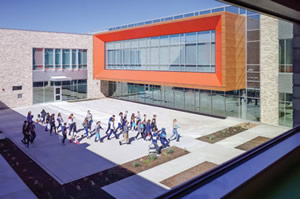
PHOTO © KURT GRIESBACH
Tag, You’re It!
Recreation and play areas serve as a backdrop for important social interactions among students. Learners form connections with their peers as they cooperate, discover, risk, and achieve together. Scheduled free play serves as one of the few times that students can interact in undirected and voluntary ways, and allows teachers to observe the social development of students outside the classroom setting. Providing physical elements and focal points such as playhouses, tree groves, sport courts, bridges, flexible seating, and manipulatives can help foster dynamic play.
Secondary students benefit from open lawns, varied seating levels for individuals and groups, strong WIFI, flexible maker spaces, and tiered amphitheaters. These spaces support independent learning, impromptu performances and project work. Seating benches for study and conversation, connecting sidewalks paths, pedestrian scale light poles, manicured lawns, and large shade trees can emulate a student’s future university setting.
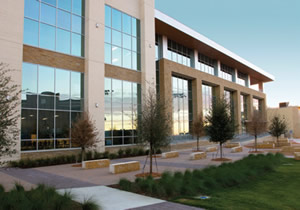
PHOTO © KURT GRIESBACH
Community Connections
The open space on the school grounds is not just a place for students to go out to, but a place to bring the community in. When Richardson ISD was selecting a site for a new learning academy and professional development center, they chose an underutilized, historic site in the center of the district, giving them an opportunity to transform it into a shared amenity for students, the city and district administration. Through collaboration and approval from the community, a rarely used football stadium on the site, dedicated in 1949 to World War II veterans of Richardson ISD, was transformed into a public park for recreation, reflection and events. A connection was made to the city hike and bike trail and a new veterans memorial was constructed using native granite. The interior student union of the Memorial Park Academy within the Arzell Ball Center opens out to a dining and study patio with views to the park, reinforcing the link between students and the broader community.
By approaching the design of a school as bounded not by its walls, or even its property line, the reciprocal influences that the students, environment and community can have on each other is unbounded. Celebrating the memory of a place, integrating sustainable systems and designing spaces for tactile engagement create layered learning opportunities. Purposeful connections made through outdoor learning environments enrich and advance student education and growth.
This article originally appeared in the February 2018 issue of School Planning & Management.